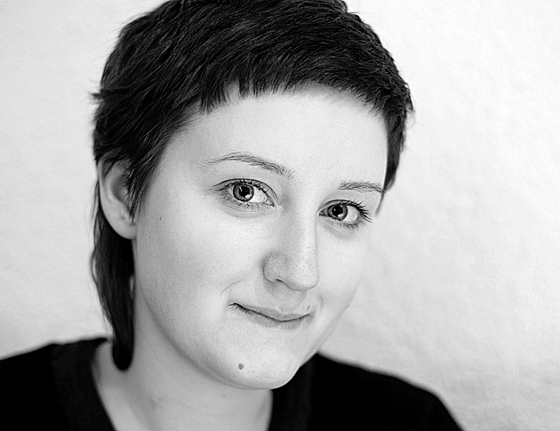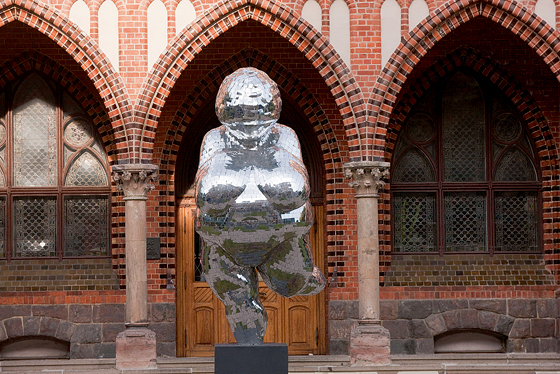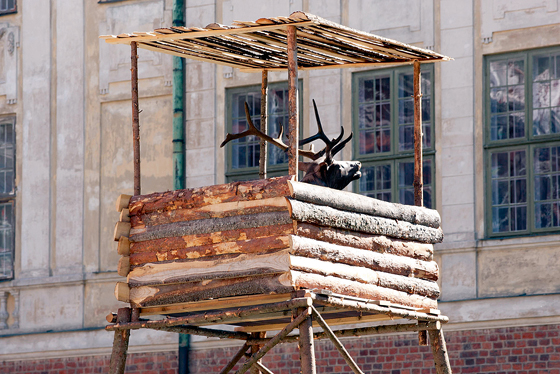|
|
| Brigita Zelča-Aispure Santa Mičule, Student, Art Academy of Latvia | |
| Brigita Zelča-Aispure (born 1986) graduated this June with a master’s degree from the Department of Visual Communication of the Art Academy of Latvia. Before that she studied in the academy’s Department of Glass Art (2010) and the Riga School of Design and Art (2006). She has been actively exhibiting her works in both Latvia and Europe since 2006. In 2009 she held a solo exhibition Smilškaste (‘Sandpit’) at Stikla Galerija, and she has also participated in major Latvian art festivals such as Staro Rīga (2010) and Survival Kit 3 (2011). Even though in her latest works she has distanced herself from glass art as too restrictive, and turned to a more conceptual mode of expression, her works convey the perfectionism of form which has been acquired from working with such a fragile material as glass. From the ideas point of view, these works could be perceived as various log entries of observed logical outcomes, where world views from the past and the present are placed in confrontation using visual symbols. This confrontation could be likened to a wide system of coordinates formed by the contact points of Western culture heritage and modern life – archetypal visual images abundant with meanings are emotionally integrated into present-day narratives. | |
 Brigita Zelča-Aispure. 2012 Photo from the private archive of Brigita Zelča-Aispure | |
| The majority of Brigita’s works in glass should be called glass sculpture, instead of glass design – the artist herself admits an interest in sculptural forms. Glass in her works functions not only as a material subjected to artistic intent, but it is also a plastically active structural element. Her sense of sculptural form is clearly evident in the collection of souvenir glasses “BB” which Brigita designed in collaboration with designer Kristaps Grundšteins and made for the Latvian National Museum of Art. The collection won the annual award for design at the competition Stikls un stils (‘Glass and Style’) in 2008. The crystal glasses were made using free-blowing technique, under the supervision of Czech glass artist Petr Novotny, and the shapes embody the plasticity and the rhythm of lines characteristic of the Latvian painting classicist Boriss Bērziņš, who is highly regarded by Brigita. Zelča-Aispure’s bachelor’s degree work Villendorfas Venera 21. gs. (‘Venus of Willendorf of the 21st Century’) marks a sort of a transition point in the artist’s creative development: the sculpture, of aesthetic value in itself, functions as an unusual environmental object. The Venus of 21st century Riga, clad in a kitschy disco ball outfit, is in dissonance with the accepted societal norms of good behaviour, and for its audacity it received a nomination for the Diena Annual Culture Award (2010). Brigita has created a coquettish image of both Stone Age and contemporary woman as a sort of an ode to femininity which is raised above superficial notions of taste and the changeable role of women in society, at the same time refusing a direct relationship with the ideas of feminism. Besides the halo of femininity that surrounds the work at idea level, the physical manifestation of the image is characterized by monumentality and substantiality, evoked in the size of the sculpture (its height is 3 metres) as well as in its complex treatment of form. This slightly aggressive feature in Riga’s public space turns out to be quite friendly and open, and its glamorous disco ball surface, that is, little pieces of mirror in polystyrene, reflects the continually changing environment, making Venus into a particular kind of environmental installation. The interactive nature of the work sets apart Brigita’s work from the fairly numerous contemporary sculpture offerings adopting similar strategies, where classical forms of sculpture are often cited simply mechanically, passively re-contextualizing the history of art, whereas Brigita rehabilitates the image of Venus of Willendorf into the language of modern sculpture as a close and important personal story. | |
 Brigita Zelča-Aispure. Venus of Willendorf 21st century. Sculpture. Mixed technique. h 4,5 m. 2010 Photo: Didzis Grodzs Publicity photos Courtesy of the artist | |
| Brigita’s work for her master’s degree Kustība. Migrācija (‘Movement. Migration’) was devised as a multi-media installation symbolically imitating the return of the forest into the city. The story of the exhibition has something of the structure of a ritual: geometrical figures made of deer food (hay) – triangle, rectangle, circle – symbolizing the city or everything that is civilized and cultivated are brought into nature (or the deer park), an environment which still functions according to ancient and untamable instincts. Many of Brigita’s works reflect her interest in geometrical structures, but her master’s work includes both references to the art trends of the 20th century, where geometry has had an important role in composition or the principles of organization of various objects (e.g., Constructivism, Minimalism, Land Art, etc.), as well as a reminder of the laws of geometry as the basic elements of Western classical aesthetics. Unintentional associations can also be made with Kaspars Podnieks’ exhibition Savienotie trauki (‘Communicating Vessels’) at the Contemporary Art Centre kim?, where the same kind of geometrical forms were used as a formal uniting feature of the works on show. The second part of Brigita’s master’s degree work was exhibited in the cross gallery of Riga Cathedral and displayed the following works: 1) a hunters’ viewing tower with a rotating deer head dummy; 2) a 15-minute video documenting the behaviour and hay eating habits of deer throughout the seasons of the year; 3) an audio installation of the sounds made by deer and 4) a quote from the psalms, engraved in stone. Even though the objects were linked by the deer theme, each of them stood on their own with their inherently different meanings (thirst for spirituality, ecological thinking, states of observation and confinement, animal instincts and the specifics of perception), creating a multilayered web of moods that cannot be explicitly formulated. The diversity of the ideas was fused by the space of the Cathedral garden and cross gallery, functioning not only as a perfectly suitable exposition environment, but imbuing the works with an even stronger spiritual dimension, solemnity and stateliness which at any other more profane venue would be lost. Brigita emphasizes that the keywords of her master’s work are communication and cooperation, therefore the result should be evaluated not as a static staging of art objects, but rather as the reflection of concrete communicative experience in an audio-visual narrative. | |
 Brigita Zelča-Aispure. Hunters watchtower. Installation from the exhibition Movement. Migration. 6x25 m. 2012 Photo: Didzis Grodzs Publicity photos Courtesy of the artist | |
| Certain parallels can be drawn with the concepts of Robert Smithson and Earth Art, though Brigita’s project and thought process is differentiated and characterized by an attitude towards nature which is that of observation, rather than manipulation. Besides, the underlying motif of the master’s work and the exhibition – the symbolic return of nature to the city – is figurative, and places Brigita’s creative work within the realm of so-called romantic (subjectively emotional) conceptualism. The leading role in Brigita’s “subjective emotionality” has been awarded to values such as the eternal, beautiful, natural and harmonious. The work ‘Movement. Migration’ gives prominence to these values not only to reveal the story about nostalgic longing, but also to point to the universal nature of migration – human migration patterns and the yearning for change is not merely connected with geographical trajectories, but also with a psychological quest for the harmonious. Translation into English: Vita Limanoviča | |
| go back | |







